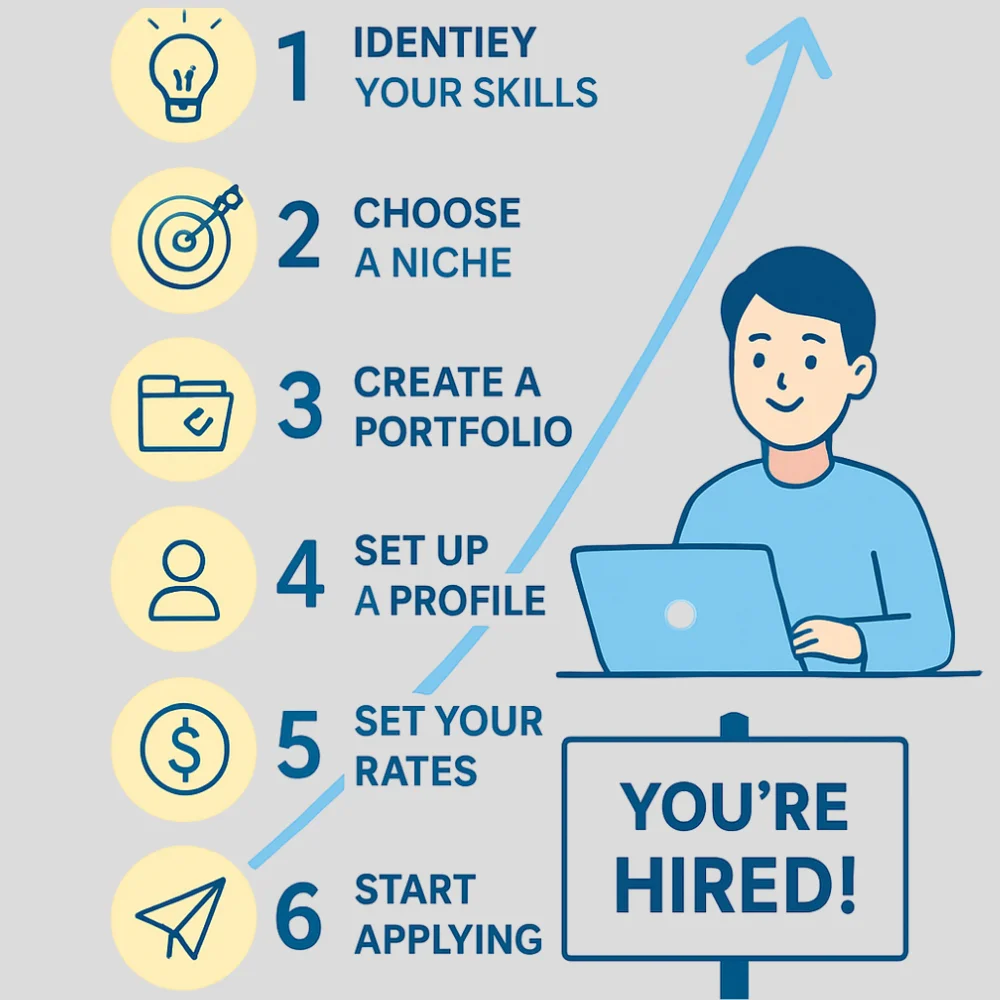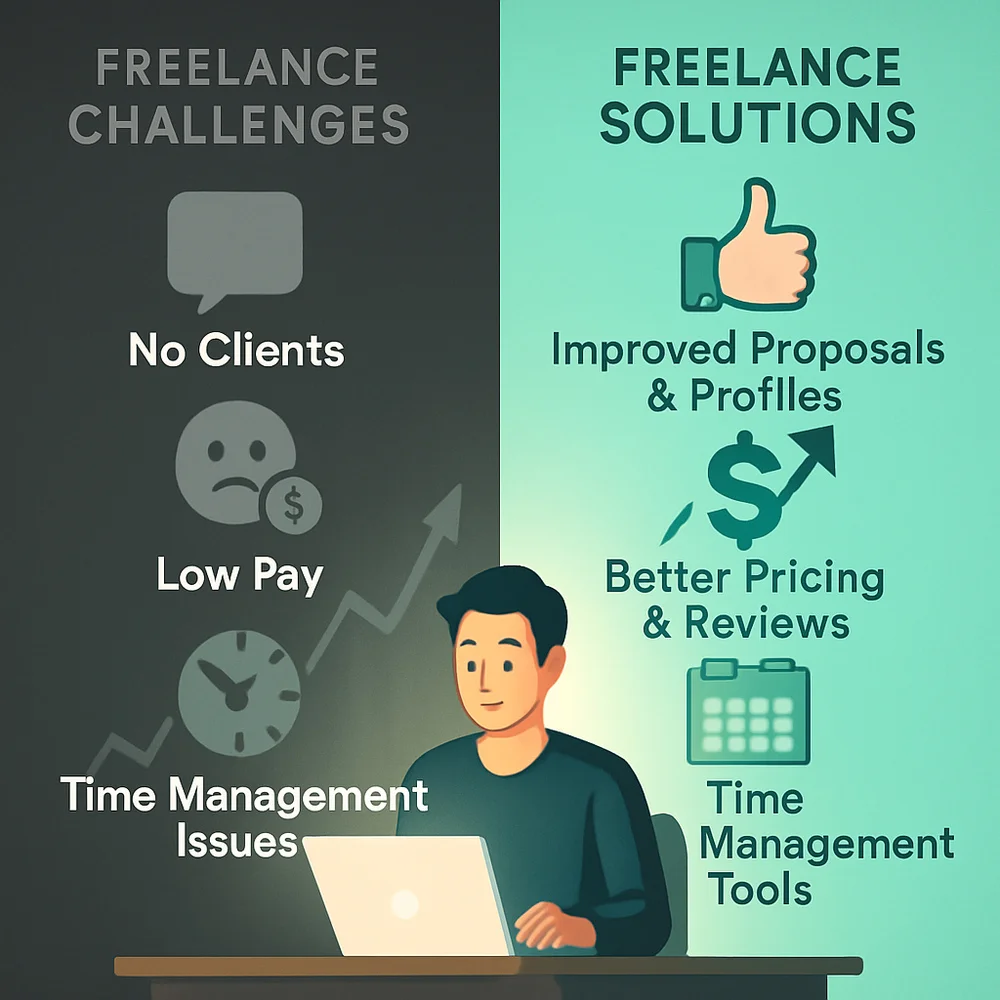In today’s digital world, earning money from your talents has never been easier. Whether you’re good at writing, designing, coding, marketing, or even just organizing things, there is someone out there who needs your help. Freelancing gives you the freedom to use what you already know and love to do—and get paid for it. You don’t need a fancy degree or years of experience to get started. With the right direction, consistent effort, and a bit of patience, you can start making real progress
What Is Freelance Work?
Freelancing involves providing your skills or services to various clients or companies without being committed to a single long-term employer. Freelancers are usually self-employed and work on short-term or long-term projects, often from the comfort of their own home or any place with internet access.
It’s like being your own boss. You decide who to work with, when to work, and how much to charge. Common freelance jobs include:
- Content writing and copywriting
- Graphic design and logo creation
- Social media management
- Web development and programming
- Translation and transcription
- Online tutoring and teaching
- Virtual assistance and data entry
Why Freelancing Is Worth Trying?
There are many good reasons why freelancing is growing around the world. Some of the most popular benefits include:
- Flexibility: You choose your own schedule
- Freedom: Work from anywhere
- Earning Potential: You set your rates and can earn more as your skills grow
- Variety: Work with different clients on different projects
- Personal Growth: You learn to manage time, handle clients, and improve your work
Whether you’re a student, a stay-at-home parent, or someone looking for a career change, freelancing offers a great way to earn money without a 9-to-5 job.
Step-by-Step Guide to Start Freelancing

Let’s walk through how you can begin your freelancing journey from scratch.
1. Identify Your Skills
First, make a list of things you are good at. These could be:
- Technical skills like coding, designing, or SEO
- Soft skills like communication, writing, organizing
- Hobby-based skills like drawing, photography, or crafting
Even if you think your skill is small, someone may need it. The most important step is recognizing the unique value you bring to others.
2. Choose a Niche
Once you know your skills, pick a specific area to focus on. For example, instead of saying “writer,” you can say “blog writer for health websites.” Specializing helps you stand out and find better clients.
Ask yourself:
- What topics do I enjoy?
- Which industries do I understand?
- What type of clients do I want to work with?
3 .Create a Portfolio
A portfolio is proof of your work. It shows clients what you can do.
If you’re just starting and don’t have real projects, you can:
- Create sample work
- Offer free work to friends or non-profits
- Do small jobs for lower rates to build experience
Put your work in a simple Google Drive folder or create a free website using platforms like Wix or Canva.
4. Set Up a Professional Profile
Join freelancing platforms and build a strong profile. The top platforms include:
- Fiverr
- Upwork
- Freelancer.com
- PeoplePerHour
- Toptal (for advanced professionals)
Your profile should include:
- A friendly photo
- A clear bio with your skills
- A list of your services
- Samples of your work
- Testimonials, if any
Tip: Use simple, friendly language and make it about how you can help the client, not just about you.
5. Decide Your Rates
Setting prices can be tricky at first. Start by checking what others in your field charge. Don’t undersell yourself, but be realistic as a beginner.
You can charge:
- Per hour (e.g., $10/hour)
- Per project (e.g., $50 per logo)
- Per word (for writers, e.g., $0.05 per word)
Keep your prices fair, and increase them as your experience and confidence grow.
6. Start Applying for Jobs
Use your freelancing platforms to find job postings. When applying:
- Read the job post carefully
- Write a short and clear proposal
- Focus on how you can help solve the client’s problem
- Add samples of your similar work
- Be polite and professional
Tip: Don’t copy-paste the same message for every job. Customize it for each client.
7 . Deliver Quality Work on Time
This is the most important part of freelancing. If you promise something, deliver it well and on time. Good work builds your reputation, gets you reviews, and brings repeat clients.
Use tools like:
- Trello or Notion for task management
- Grammarly for writing help
- Canva for design
- Google Docs/Drive for sharing work
Stay in touch with your client, ask questions if needed, and always double-check your work before submitting.
8. Build Relationships
Good communication is key to freelancing. Be friendly, professional, and clear. After a project ends, don’t be afraid to ask for:
- A review
- A recommendation
- Future work
Your happy clients are your best marketing tool.
Where to Find Freelance Jobs Besides Platforms?
While websites like Fiverr and Upwork are great, there are other ways to get freelance jobs:
- Social Media: Post your skills on LinkedIn, Facebook groups, and Instagram
- Cold Emailing: Contact businesses and offer your services
- Word of Mouth: Let friends and family know you’re freelancing
- Freelance Job Boards: Sites like We Work Remotely, ProBlogger, and RemoteOK
- Local Business Help: Small shops often need help with marketing or online tasks
The more places you show up, the more chances you have of landing a job.
Common Challenges and How to Beat Them?

Freelancing sounds fun, but it comes with its own struggles. Let’s look at a few common ones and how to deal with them:
-
Not Getting Clients
Solution: Keep improving your profile, send better proposals, and work on your samples. Be patient—it takes time to build momentum.
-
Low Pay at First
Solution: Focus on gaining reviews and experience. Start with small projects and raise your rates as you go.
-
No Job Security
Solution: Work with multiple clients, keep saving money, and always look for new opportunities.
-
Time Management Issues
Solution: Use a planner, set daily work goals, and take breaks. Treat freelancing like a real job.
Smart Tips to Grow Faster
If you want to move from beginner to pro, follow these tips:
- Keep learning with free courses on YouTube, Coursera, or LinkedIn Learning
- Follow other freelancers to see how they present themselves
- Stay active online share your work and connect with potential clients
- Learn basic business skills like sending invoices and managing money
- Stay consistenteven if you only do a little each day
Tools to Make Freelancing Easier
Here are some simple tools that make freelancing more manageable:
- Canva: Design social posts, CVs, banners, and more
- Grammarly: For spelling and grammar checking
- Google Workspace: Docs, Sheets, Drive, Gmail, Calendar
- Toggl: To track your time
- Google Workspace / Wise: To receive international payments
- Notion: All-in-one productivity tool
Using the right tools helps you work smarter, not harder.
Freelance Success Stories for Inspiration
- A college student used her love for writing to earn side income on Fiverr. Now she runs her own blog.
- A graphic designer who lost his job started freelancing on Upwork. He now earns more than before.
- A teacher began tutoring kids online and turned it into a full-time business.
- Your story can be next. Every expert was once a beginner. What matters most is getting started.
Final Thoughts
Freelancing is not just a side hustle it can be a life-changing career. With the right mindset, basic tools, and a bit of effort, anyone can turn their skills into a real income. Avoid waiting for the ideal time or flawless expertise begin with what you have, stay steady, and grow through the journey. The freelance world is big, and there’s a place in it for you.



